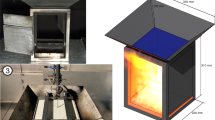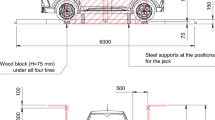Abstract
As part of the United Nations Global Technical Regulation No. 13 (UN GTR #13), vehicle fire safety is validated using a localized and engulfing fire test methodology and currently, updates are being considered in the on-going Phase 2 development stage. The GTR#13 fire test is designed to verify the performance of a hydrogen storage system of preventing rupture when exposed to service-terminating condition of fire situation. The test is conducted in two stages—localized flame exposure at a location most challenging for thermally-activated pressure relief device(s) (TPRDs) to respond for 10 min. followed by engulfing fire exposure until the system vents and the pressure falls to less than 1 MPa or until “time out” (30 min. for light-duty vehicle containers and 60 min. for heavy-duty vehicle containers). The rationale behind this two-stage fire test is to ensure that even when fire sizes are small and TPRDs are not responding the containers have fire resistance to withstand or fire sensitivity to respond to a localized fire to avoid system rupture. In this study, appropriate fire sizes for localized and engulfing fire tests in GTR#13 are evaluated by considering actual fire conditions in a hydrogen-powered electric city bus. Quantitative risk analysis is conducted to develop various fire accident scenarios including regular bus fire, battery fire, and hydrogen leak fire. Frequency and severity analyses are performed to determine the minimum fire size required in GTR#13 fire test and the design guides to ensure hydrogen storage tank safety in hydrogen-powered electric city buses.












Similar content being viewed by others
References
UN GTR No. 13 (2013) Global Technical Regulation Concerning the Hydrogen and Fuel Cell Vehicles, ECE/TRANS/180/Add.13. http://www.unece.org/wp29.html
KATRI Report on rollover test, 1-C-1-(2), 2020
United Nations Economic Commission for Europe (Feb. 22, 2006). Regulation 66, Addendum 65, uniform technical prescriptions concerning the approval of large passenger vehicles with regard to the strength of their superstructure
Regulation No. 100 Revision 1 (2013) Amendment 2. Uniform provisions concerning the approval of vehicles with regard to specific requirements for the electric power train: UNITED NATIONS. 12 August
DNV Partner Group (2019) Technical reference for Li-Ion battery explosion risk and fire suppression, Report # 2019-1025, rev.4
Rodionov A, Wilkening H, Moretto P (2011) Risk assessment of hydrogen explosion for private car with hydrogen-driven engine. Int J Hydrogen Energy 36(3):2398–2406
Oil & Gas Producers (2010) Risk assessment data directory, Report No. 434-1. March
American Institute of Chemical Engineers (2015) Center for chemical process safety. Guidelines for initiating events and independent protection layers in layer of protection analysis. Wiley, Hoboken
Groth KM, Zumwalt HR, Clark AJ (2016) HyRAM V1.0 User Guide. United States: N. p. Web. https://doi.org/10.2172/1431287
JARI (2018) SAE Task Force #4 Meeting Report, June 6
Phase 2 UN GTR No. 13 (2022) Global technical regulation concerning the hydrogen and fuel cell vehicles, ECE/TRANS/180/Add.13 draft
Pitts WM et al (2006) Round robin study of total heat flux gauge calibration at fire laboratories. Fire Saf J 41(6):459–475
McGrattan K et al. (2020) “Fire dynamics simulator (version 6), user’s guide.” NIST special publication 1019.6
Dillon SE (1998) Analysis of the ISO 9705 Room/Corner Test: simulations, correlations and heat flux measurements. No. Grant/Contract Reports (NISTGCR)-98-756
Back G et al (1994) Wall incident heat flux distributions resulting from an adjacent fire. Fire Saf Sci 4:241–252
ISO/TR 9705-2:2001. Reaction-to-fire tests — Full-scale room tests for surface products – Part 2: Technical background and guidance, ISO Geneva
Ehrhart B, Hecht E (2022) Hydrogen Plus Other Alternative Fuels Risk Assessment Models (HyRAM+) Version 5.0 Technical Reference Manual. No. SAND2022-16425. Sandia National Lab. (SNL-NM), Albuquerque, NM (United States); Sandia National Laboratories, Livermore, CA
Sun P, Bisschop R, Niu H, Huang X (2020) A review of battery fires in electric vehicles. Fire Technol 1–50
Cheong MK, Spearpoint MJ, Fleischmann CM (2008) Design fires for vehicles in road tunnels
Acknowledgements
This work is supported by the Korea Agency for Infrastructure Technology Advancement (KAIA) grant funded by the Ministry of Land, Infrastructure and Transport (Grant 22HBST-C158081-03).
Author information
Authors and Affiliations
Corresponding authors
Ethics declarations
Conflict of interest
None declared.
Additional information
Publisher's note
Springer Nature remains neutral with regard to jurisdictional claims in published maps and institutional affiliations.
Rights and permissions
Springer Nature or its licensor (e.g. a society or other partner) holds exclusive rights to this article under a publishing agreement with the author(s) or other rightsholder(s); author self-archiving of the accepted manuscript version of this article is solely governed by the terms of such publishing agreement and applicable law.
About this article
Cite this article
Kim, E., Kim, W.K., Kim, K.S. et al. Minimum Fire Size for Hydrogen Storage Tank Fire Test Protocol and Design Guides for Hydrogen Bus Established via Risk-Based Approach. Fire Technol 59, 2499–2515 (2023). https://doi.org/10.1007/s10694-023-01432-5
Received:
Accepted:
Published:
Issue Date:
DOI: https://doi.org/10.1007/s10694-023-01432-5




